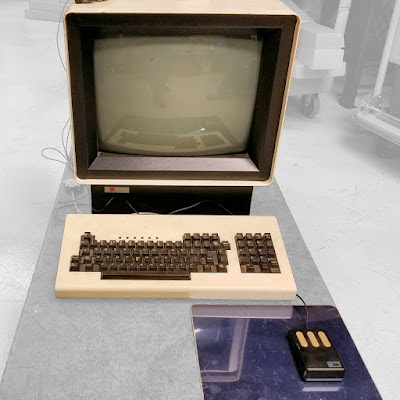Available May 1982
If you wanted to put a computer on your desk in 1982, there were a wide variety of choices. Businesses might go a system like the IBM PC or Victor 9000, home users might go for something like a VIC 20 or TI-99/4A. If you had more exotic requirements there were high-end devices such as the GRiD Compass or Xerox Star. The Sun-1 workstation – first shipping in May 1982 – fell firmly into the last category, putting minicomputer power in the hands of the individual.
 |
| Sun-1 Workstation |
The Sun-1 was the first commercial product of Sun Microsystems, which had grown out of a workstation project started at Stanford University – the name “SUN” was derived from “Stanford University Network”. The original series of Sun workstations were built for on-campus use only, but the Sun-1 took that experience and turned it into a commercial product.
Designed to be powerful enough to run UNIX or other multitasking OSes, the CPU was the surprisingly modest Motorola 68000 coupled with 256KB of RAM out of the box, which was upgradeable to 2MB. Custom Sun silicon enabled the CPU to reliably support multitasking, the 1024 x 800 pixel graphics also had hardware acceleration. The standard display was a 17” CRT although other options were available. Although it was designed as a single-user computer, you could hook up to two text terminals to the back to use it as a small-scale minicomputer.
Expansion options were comprehensive including Ethernet, mass storage and other peripherals. In a rackmount version the Sun-1 made a capable server, but its real home was sitting on a desk or in a lab where all the power could be used by just one person. It wasn’t cheap of course, starting at $8900 at 1982 prices (around $25,000 today) so it was limited to those organisations that had the budget and the need for that much computing power.
 |
| Another Sun-1 Workstation |
As a product it was still a little rough around the edges, but a year and a half later the Sun-2 came out with both improved internal hardware and a more professional external design. The Sun-2 and the Sun-3 (launched in 1985) established Sun Microsystems as the player to beat in the workstation market.
Sun itself thrived until 2001 when it was badly hit by the collapse of the dot-com bubble, and the following years were dominated by red ink in the balance books, caused in part by more powerful Intel-based machines running Windows and Linux which could outperform and undercut Sun's products at the same time. In 2009 Sun were bought out by Oracle, and although Oracle still sells servers based on Sun architecture you probably wouldn't know it. Oracle - after all - has a reputation of where good products go to die.
Image credits:
Richard Masoner / Cyclelicious via Flickr - CC BY-SA 2.0
Carlo Nardone via Flickr - CC BY-SA 2.0

No comments:
Post a Comment